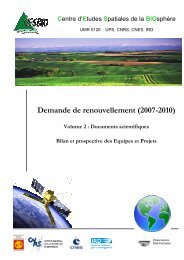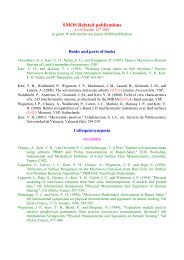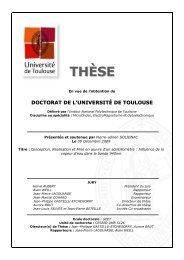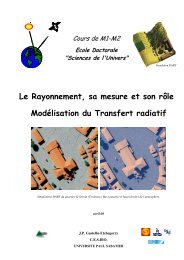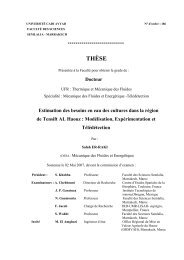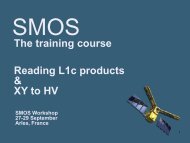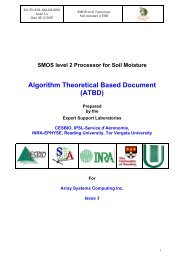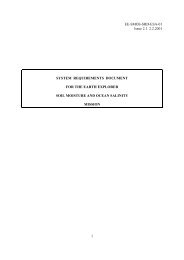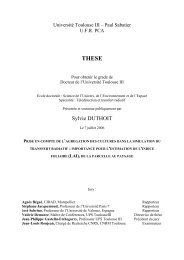THÃS EE - CESBIO - Université Toulouse III - Paul Sabatier
THÃS EE - CESBIO - Université Toulouse III - Paul Sabatier
THÃS EE - CESBIO - Université Toulouse III - Paul Sabatier
Create successful ePaper yourself
Turn your PDF publications into a flip-book with our unique Google optimized e-Paper software.
Chapitre 3. Article 1As predicted by the model, the class separability decreases in the experimental dataset whenthe ambiguity ratio increases, but its decrease is expectedly less important in the experimentaldata than in the model. Consequently, the experimental additional error increases withambiguity similarly to the theoretical error, but to a lower extent. The observed experimentaltrends related to the error are well described by the model.VI. CONCLUSIONA new expression for the probability of error in classification methods based on a SARintensity ratio has been provided, introducing a supplementary parameter corresponding to abias between measured and true ratios.This error model has been used to assess the impact of SAR system parameters on theclassification performance for the two-class problem. The effect of channel gain imbalanceand radiometric stability has been directly estimated in the general case. When the two classesare fairly separable (i.e. the difference between their mean ratios is higher than 4dB), it wasfound that typical values of channel gain imbalance lead to a negligible additional error, whilethe impact of radiometric instability can be significant in its upper range for some values ofthe equivalent number of looks in classifications based on a temporal change. The case ofclose classes discriminated through the use of a high equivalent number of looks is verysensitive to channel gain imbalance or to radiometric stability for methods based respectivelyon a polarization ratio or a temporal change, and require low values of these calibrationparameters. The effect of cross-talk on the backscattering coefficient was modelled and foundto be critical when cross-polarizations are involved, unless stringent requirements are met.Degradation due to ambiguity was found to be negligible when the ambiguity ratio is lowerthan -30dB. In other cases, some configurations can lead to critical additional errors andshould be avoided (low class separability, low number of looks). Typical temporalbackscattering profiles have been modelled to investigate the impact of observation frequencyin both methods. Simulations have demonstrated the importance of the temporal sampling,corresponding to the time lapse between two consecutive satellite’s repeat-pass orbits, formethods based on a temporal change. This reinforces the expectations set on the coming highrepetitionSAR mission Sentinel-1.The model has been validated by comparing its outputs to experimental results obtained fromreal SAR data used in rice field mapping methods. The sensitivity of the error model tochannel gain imbalance, radiometric stability and ambiguity is tested, and shows a relativelygood agreement between experimental and theoretical trends.In summary the error model proposed in this paper is expected to provide a useful tool forSAR mission design, also suitable for the development of classification methods based onexisting instruments.APPENDIX IThe retained classification threshold is r t = d.r 0 .L L−1d.r0rBr0 2L( rB+ r)rtΓ(2L)Γ(2L)PEB= ∫ p(r | rB) dr =dr = I22 B0Γ(L)∫Γ(L)The substitution s=r B +r and the use of the generalized binomial theorem lead to:∞⎛ L −1⎞k k L−1−k− ∑⎜⎟(−1)rBsLL 1d . r0 + rBr −L d r + rBB( s rB). 0 k=0=⎝ kI⎠B ∫ds = rB⋅rL ∫ds2Br2LsBs97




